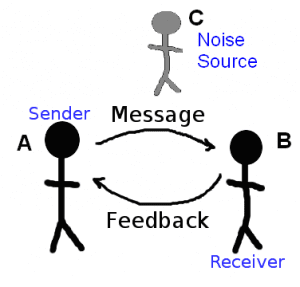 We have many traits that make us uniquely human. Among them is our ability to engage in complex communications. We can look at black ink squiggled on a piece of bleached paper and derive meaning from those symbols. We call that skill reading comprehension.
We have many traits that make us uniquely human. Among them is our ability to engage in complex communications. We can look at black ink squiggled on a piece of bleached paper and derive meaning from those symbols. We call that skill reading comprehension.
And we can listen to and comprehend the meaning of more than 10,000 words. We call that listening comprehension. Indeed our ability to communicate is quite complex.
But our complex communications system has a downside also – complex miscommunications – the focus of this article.
The communications challenge
Communicating effectively is difficult enough when we’re operating in our relatively low-stress day-in and day-out lives. You probably experience examples of miscommunications all the time in conversations with people. This can get compounded by talking on the phone instead of in person (because we miss the non-verbal communications of body language). It can get more complicated when we communicate in writing (e.g., email and texting) because we lose the communication meaning of voice inflection.
When you add stress into the equation, communications can become even more challenging because stress can limit your ability to hear (literally… it’s called auditory exclusion). Stress can also impact your ability to comprehend the meaning of complex communications.
The English language is complex, full of symbolism, synonyms, antonyms, homonyms, homophones, acronyms, abbreviations, similes, and metaphors. No wonder we can’t keep it all straight.
Sender and receiver
 The message sent always seems clear to the sender but it may not be so clear to the receiver. This can be complicated by stress as the sender may find him or herself thinking they’re saying something a certain way when, in actuality, the words came out differently. What the receiver understands as the message may not actually match the words that were heard. Can you see how communications can quickly contribute to flawed situational awareness when two or more people are dependent on communications being commonly understood?
The message sent always seems clear to the sender but it may not be so clear to the receiver. This can be complicated by stress as the sender may find him or herself thinking they’re saying something a certain way when, in actuality, the words came out differently. What the receiver understands as the message may not actually match the words that were heard. Can you see how communications can quickly contribute to flawed situational awareness when two or more people are dependent on communications being commonly understood?
Here’s a brief video to demonstrate the power of miscommunications. It’s old, but it’s classic.
Common terminology and practice in context
 One way to improve communications is to use common terminology. Everyone uses the same word, or phrase, in a commonly understood context. This takes some work and some practice. Standard operating guidelines are a good way to get responders dialed in on those common terms and meaning. However, it’s simply not good enough just to write it down. It has to be practiced. And it’s simply not good enough to practice it. It has to be practiced in an environment similar to what will be experienced when the terms are being used (realistic). And, it’s simply not good enough to practice it in a context appropriate environment. It has to be practiced repetitively to turn the use of the terms into a habit.
One way to improve communications is to use common terminology. Everyone uses the same word, or phrase, in a commonly understood context. This takes some work and some practice. Standard operating guidelines are a good way to get responders dialed in on those common terms and meaning. However, it’s simply not good enough just to write it down. It has to be practiced. And it’s simply not good enough to practice it. It has to be practiced in an environment similar to what will be experienced when the terms are being used (realistic). And, it’s simply not good enough to practice it in a context appropriate environment. It has to be practiced repetitively to turn the use of the terms into a habit.
A while back I was told about a fire department who abandoned the use of the acronym LUNAR in their mayday operations. LUNAR stands for Location, Unit, Name, Assignment, Resource needs. The department had trained personnel on LUNAR in calm, classroom conditions. Then they put responders under stress in a training scenario and had them call a mayday and give a LUNAR report. The crews did not do well in remembering what the acronym meant and providing the right information. So they scrapped the use of a LUNAR report. The department had failed to train their members to use LUNAR in conditions similar to what they would face in a real mayday and then, of course, when they had to use it, they weren’t good at it. I encouraged them to revisit their decision and consider training and practicing LUNAR in high-stress environments. They have since reported back that it worked and they’re members are good at it now.
Rich Gasaway’s Advice
 Develop a list of common terminology used in emergency situations. Then build communications into training scenarios using the common terminology. It’s too easy to overlook this seemingly obvious advice. When we train we’re all together, face-to-face, often in low stress or no stress environments with no time compression and no consequences. Communicating to each other is easy (or I should say… easier) under these conditions. It’s also unrealistic.
Develop a list of common terminology used in emergency situations. Then build communications into training scenarios using the common terminology. It’s too easy to overlook this seemingly obvious advice. When we train we’re all together, face-to-face, often in low stress or no stress environments with no time compression and no consequences. Communicating to each other is easy (or I should say… easier) under these conditions. It’s also unrealistic.
It has been my observation that many public safety organizations overlook the importance of having commonly understood, easy to remember, radio terminology. Further, they fail to build communications into their training scenarios, missing a valuable opportunity to build a skill set in a simulated stressful environment.
Second, teach members what NOT to say on a radio. Excessive radio traffic causes our brain to start filtering out the “noise” and when this happens you stop paying attention to the radio. Noise also impacts situational awareness because it can slow down the processors in the brain that help you understand things. This is easy to test. Just try to read and concentrate on something while some obnoxious noise is present. The favorite music of my teenage sons might be a good stimuli to use.
Action Items
 1. Review your standard operating guidelines to ensure they identify and define common radio communications. If you don’t have written guidelines, then discuss and identify common radio communications you should be using.
1. Review your standard operating guidelines to ensure they identify and define common radio communications. If you don’t have written guidelines, then discuss and identify common radio communications you should be using.
2. Listen to tapes of past incidents to identify communications challenges that need to be addressed and fixed. Alternatively, listen to the audio tracks of incidents on YouTube and make comparisons to your own department’s radio communications.
3. Read casualty reports from the National Institute of Occupational Safety and Health (NIOSH) to improve your understanding of how complex miscommunications is a contributing factor to flawed situational awareness.
_____________________________________________________

If you are interested in taking your understanding of situational awareness and high-risk decision making to a higher level, check out the Situational Awareness Matters Online Academy.
CLICK HERE for details, enrollment options and pricing.
__________________________________
Share your comments on this article in the “Leave a Reply” box below. If you want to send me incident pictures, videos or have an idea you’d like me to research and write about, contact me. I really enjoy getting feedback and supportive messages from fellow first responders. It gives me the energy to work harder for you.
Thanks,

Email: Support@RichGasaway.com
Phone: 612-548-4424
SAMatters Online Academy
Facebook Fan Page: www.facebook.com/SAMatters
Twitter: @SAMatters
LinkedIn: Rich Gasaway
YouTube: SAMattersTV
iTunes: SAMatters Radio

“One way to improve communications is to use common terminology”…
Interestingly enough, I was just reviewing a list of 400 Terms Every Firefighter Candidate Should Know. And, was considering how difficult it must be for a new recruit to master the technical skills required to fight fires, as well as, expand their vocabulary and understanding of hundreds of new words. The answer is, as you mention: “build communications into their training scenarios”.
Our mantra at our station is: Train as you fight, fight as you train! This was a great reminder to continually improve on communications!
Again Rich, another amazingly insightful article!
Thanks,
Mark
Mark,
Thanks for taking the time to reply and for your supportive comments on my mission. I REALLY do appreciate your support and participation in the discussion. You’re so right about how challenging it is… not just for the new recruits. We have to keep that level of vocabulary fresh for ALL members. I love your mantra! Excellent for building the right mindset.
Rich
Hello Mr. Gasaway,
I would like to congratulate you on your work.
I enjoy reading all your articles.
Please continue. He only thing I wish was that your information would also in French.
In this province ( Quebec) trainnig is not of the best quality.
As for officer training well forget that practically none exist!!
Great article. I feel a deep sense of gratitude for the timing of this particular writing. Stress certainly can affect communication in ways that are difficult for some to comprehend. I have witnessed this personally. I would like an opportunity to discuss the unconsidered and unmeasured capabilities of the 12 cranial nerves. The 2-way afferent and efferent capacity of these nerves is vital to communication.